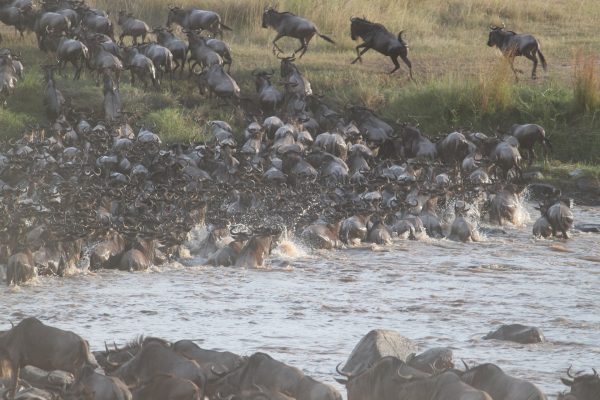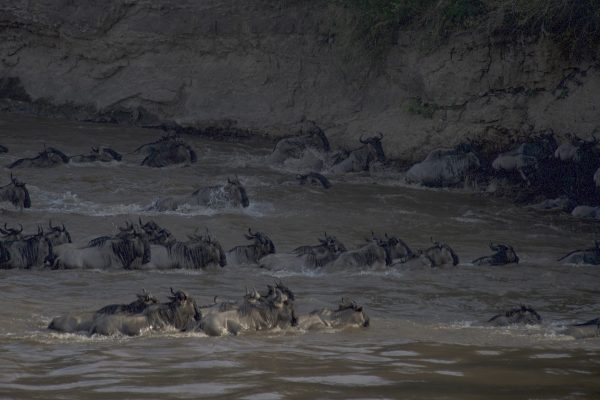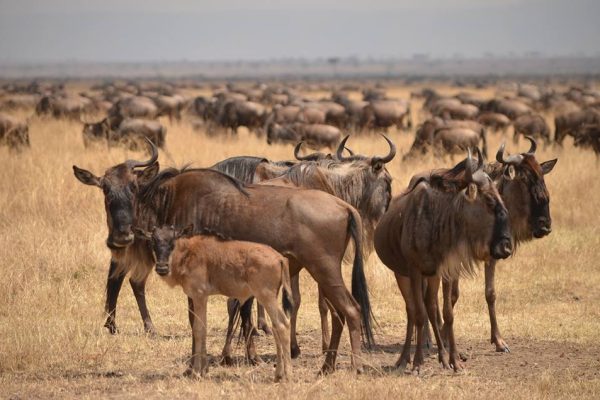Where to See the Wildebeest Migration in Tanzania And When to Go
The Wildebeest Migration involves millions of animals making the perilous journey between the Serengeti and the Maasai Mara in Kenya, rather than thousands or hundreds of thousands. The zebra, gazelle, and wildebeest make up the majority of this migration, but predators stalk the stragglers.
However, when is the best time to witness the Wildebeest Migration?
You can witness the beginnings of this migration during calving season in Ndutu, the beautiful river crossings on the Mara River, or the return journey from Kenya’s Maasai Mara. This migration covers a great distance and results in the deaths of almost 250,000 wildebeest every year.
The Wildebeest Migration is a beautiful and sometimes upsetting insight into the realities of life on the plains of Africa when it comes to recording the rhythms and the often-casual mortality of life for Africa’s herbivores.



The Wildebeest Migration
The annual migration of wildebeest takes place from the Ndutu region of Tanzania’s Ngorongoro Conservation Area and the southern Serengeti to Kenya’s Maasai Mara.
The beautiful caldera reserve provides plenty of grass for zebra and wildebeest to eat from December to March as a result of the recent rains, and this is also the time of year when the wildebeest calving season starts. Predators like lions, cheetahs, leopards, and hyenas take advantage of the weak and confused calves to prey on them.
The zebra starts moving northward toward the Maasai Mara when the rains stop in April or May. The wildebeest follow the zebra everywhere goes.
Some of the most breathtaking pictures and videos can be taken when the enormous herd crosses the Grumeti River in June/July and the Mara River between August and November. As animals enter the water in an attempt to cross, swelling rivers sweep away members of the herd, predators pursue the lone survivors, and opportunistic Nile crocodiles feast. It is a violent, wonderful demonstration of the food chain in action.
After the successful completion of the crossings, the herd makes its way to Kenya’s Maasai Mara. The migration moves south once more in expectation of another calving season in the new year.
The best places to view the Wildebeest Migration
It is challenging to estimate with any degree of confidence when the Wildebeest Migration will occur because the precise timing of the migration is entirely reliant upon rainfall patterns. Particularly light or heavy rain could drastically change how the big herd moves.
This can occasionally make it difficult to organize your safari, so it is beneficial to spend as much time as you can in the Serengeti to become used to the herd’s unusual movements.
Even though the herd can be unpredictable, our team has a general concept of where the action will be at any given time of the year.
the season for calves is from January to late March (Ndutu Region, Tanzania)
On the lush plains around Lake Ndutu and Lake Masek, a great number of animals start their lives each year. On any given day, around 10,000 wildebeest give birth and make their unsteady entrance on the long trek up north.
Over a few short months, over a million wildebeest will increase the size of the already large herd and feast on the lush grass that emerges from the fertile volcanic soil that has been well-watered by the rainy season.
A number of tented camps and lodges open up each year from December through to March to meet the demand for a front-row seat to the calving season in the Ndutu region of the southern Serengeti. The calving season is less active than in later months because the herd has a lot of food and the relative safety of large open plains to aid in spotting potential predators.
Green Season, from April through May (Central Serengeti, Tanzania)
The first zebra starts to migrate north as food becomes more difficult in the south as a result of the dry weather and an increase in the number of mouths to feed.
Wildebeest generally follow zebra wherever they go.
Around 1.7 million wildebeest, close to 500,000 antelope, and a quarter of a million zebra begin the annual Wildebeest Migration.
Seronera, located right in the middle of the Serengeti, is their first stop.
Throughout the year, the Seronera region provides good opportunities for watching wildlife, but during this season, the big cats and wandering elephants are increased by the passing herd.
If you’re on a low budget, the green season is the best time to organize your safari. Luxury lodges reduce their fees to a point where they are on par with plains camping since the nighttime rains keep the tourist crowds away.
The Western Corridor from mid-May until mid-July (Grumeti, Tanzania)
The Grumeti River crossing in the Western Serengeti is no less impressive than the Mara River crossing, which may be the Wildebeest Migration’s most well-known high point.
The herd diverges into the west as it is attracted by the promise of rain and better grazing near the Lake Victoria shoreline, which is Africa’s largest lake.
The Nile crocodiles and big cats both take advantage of this opportunity to attack the increasingly scared members of the herd in some of the most beautiful pictures of the predator-prey dynamic that have ever been taken in and around the river.
The largest number of Nile crocodiles in the area may be found in the Grumeti, and these opportunistic predators take advantage of any situation.
River-Crossing Season runs from July to September (Northern Serengeti, Tanzania, and Maasai Mara, Kenya)
The herd keeps moving north toward Kenya’s Maasai Mara during this time. These creatures don’t have a strict schedule, so observing their daily movements becomes a challenge as they wander slowly but inescapably toward the Mara River, the next significant barrier in their way.
The herd must once more brave flooded waters and opportunistic predators in order to cross the Mara River and find relative safety on the other side.
Photographers and documentarians from all over the world flock to witness the death-defying crossing, but the surrounding landscapes are just as memorable as the life-or-death struggle at the Kogatende crossing.
September to November
At the conclusion of every year, the Maasai Mara (Kenya) and Tanzania transfer control of the Wildebeest Migration for a few months. The herd travels over the Mara River before entering the Maasai Mara in southern Kenya.
Low Season: November – December (Northern and Central Serengeti, Tanzania)
Once the Wildebeest Migration has crossed back over the Mara River into Tanzania, the herd can be seen in Kogatende, Lobo, or the Central Serengeti as it makes its way back south.
